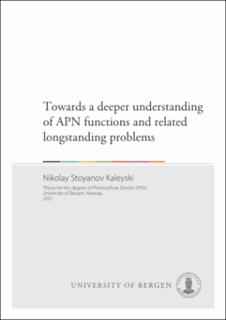Towards a deeper understanding of APN functions and related longstanding problems
Doctoral thesis
Permanent lenke
https://hdl.handle.net/11250/2770059Utgivelsesdato
2021-08-24Metadata
Vis full innførselSamlinger
Sammendrag
This dissertation is dedicated to the properties, construction and analysis of APN and AB functions. Being cryptographically optimal, these functions lack any general structure or patterns, which makes their study very challenging. Despite intense work since at least the early 90's, many important questions and conjectures in the area remain open. We present several new results, many of which are directly related to important longstanding open problems; we resolve some of these problems, and make significant progress towards the resolution of others.
More concretely, our research concerns the following open problems: i) the maximum algebraic degree of an APN function, and the Hamming distance between APN functions (open since 1998); ii) the classification of APN and AB functions up to CCZ-equivalence (an ongoing problem since the introduction of APN functions, and one of the main directions of research in the area); iii) the extension of the APN binomial $x^3 + \beta x^{36}$ over $F_{2^{10}}$ into an infinite family (open since 2006); iv) the Walsh spectrum of the Dobbertin function (open since 2001); v) the existence of monomial APN functions CCZ-inequivalent to ones from the known families (open since 2001); vi) the problem of efficiently and reliably testing EA- and CCZ-equivalence (ongoing, and open since the introduction of APN functions).
In the course of investigating these problems, we obtain i.a. the following results: 1) a new infinite family of APN quadrinomials (which includes the binomial $x^3 + \beta x^{36}$ over $F_{2^{10}}$); 2) two new invariants, one under EA-equivalence, and one under CCZ-equivalence; 3) an efficient and easily parallelizable algorithm for computationally testing EA-equivalence; 4) an efficiently computable lower bound on the Hamming distance between a given APN function and any other APN function; 5) a classification of all quadratic APN polynomials with binary coefficients over $F_{2^n}$ for $n \le 9$; 6) a construction allowing the CCZ-equivalence class of one monomial APN function to be obtained from that of another; 7) a conjecture giving the exact form of the Walsh spectrum of the Dobbertin power functions; 8) a generalization of an infinite family of APN functions to a family of functions with a two-valued differential spectrum, and an example showing that this Gold-like behavior does not occur for infinite families of quadratic APN functions in general; 9) a new class of functions (the so-called partially APN functions) defined by relaxing the definition of the APN property, and several constructions and non-existence results related to them.
Består av
Paper 1: N.S. Kaleyski. Changing APN functions at two points. Cryptography and Communications 11, 1165–1184 (2019). The article is available in the thesis file. The article is also available at: https://doi.org/10.1007/s12095-019-00366-6Paper 2: L. Budaghyan, C. Carlet, T. Helleseth, N. S. Kaleyski. On the Distance Between APN Functions. IEEE Transactions on Information Theory, vol. 66, no. 9, pp. 5742-5753, Sept. 2020. The article is available at: https://hdl.handle.net/11250/2756701
Paper 3: Y. Yu, N. S. Kaleyski, L. Budaghyan, Y. Li. Classification of quadratic APN functions with coefficients in F2 for dimensions up to 9. Finite Fields and Their Applications, Volume 68, 2020, 101733. The article is available at: https://hdl.handle.net/11250/2756786
Paper 4: L. Budaghyan, T. Helleseth, N. Kaleyski. A New Family of APN Quadrinomials. IEEE Transactions on Information Theory, vol. 66, no. 11, pp. 7081-7087, Nov. 2020. The article is available at: https://hdl.handle.net/11250/2756784
Paper 5: N. S. Kaleyski. Deciding EA-equivalence via invariants. Cryptography and Communications, 2021. The submitted version is available in the thesis file. The published version is available at: https://doi.org/10.1007/s12095-021-00513-y
Paper 6: D. Davidova, N. S. Kaleyski. Generalization of a class of APN binomials to Gold-like functions. In: Bajard J.C., Topuzo˘glu A. (eds) Arithmetic of Finite Fields. WAIFI 2020. Lecture Notes in Computer Science, vol. 12542. The article is available in the thesis file. The article is also available at: https://doi.org/10.1007/978-3-030-68869-1_11
Paper 7: L. Budaghyan, N. S. Kaleyski, S. Kwon, C. S. Riera, P. Stanica. Partially APN Boolean functions and classes of functions that are not APN infinitely often. Cryptography and Communications 12, 527–545 (2020). The article is available in the thesis file. The article is also available at: https://doi.org/10.1007/s12095-019-00372-8
Paper 8: L. Budaghyan, N. S. Kaleyski, C. S. Riera, P. Stanica. Partially APN functions with APN-like polynomial representations. Designs, Codes and Cryptography 88, 1159–1177 (2020). The article is available at: https://hdl.handle.net/11250/2756790
Paper 9: L. Budaghyan, M. Calderini, C. Carlet, D. Davidova, N. S. Kaleyski. On two fundamental problems on APN power functions. Cryptology ePrint Archive: Report 2020/1359. The article is not available in BORA. The preprint version is available at: https://eprint.iacr.org/2020/1359.pdf
